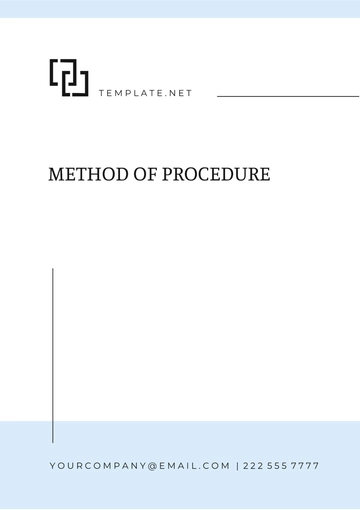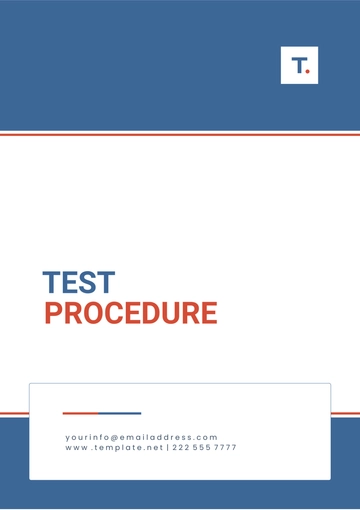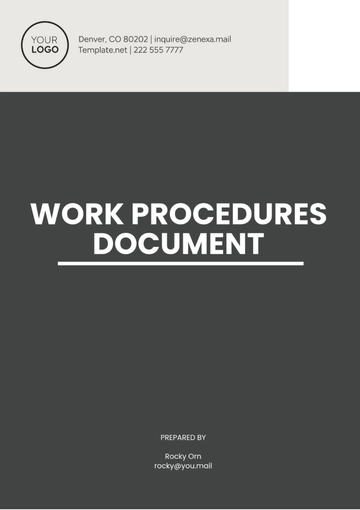Free Agriculture Financial Procedure

I. Introduction
A. Purpose of the Financial Procedure
The purpose of this financial procedure document is to establish a standardized approach to managing and overseeing the financial activities of [Your Company Name]'s agricultural operations. This procedure aims to ensure that all financial transactions are conducted in a transparent, consistent, and compliant manner, thereby enhancing financial accountability and supporting the overall financial health of the organization.
B. Scope of Application
This financial procedure applies to all financial activities related to [Your Company Name]'s agricultural operations, including but not limited to budgeting, revenue management, expense management, financial reporting, cash flow management, asset management, financial risk management, internal controls, auditing, compliance, and regulatory requirements. All employees and stakeholders involved in the financial processes of the agricultural operations are required to adhere to these procedures.
C. Definitions and Terminology
To ensure clarity and uniform understanding, the following key terms are defined as follows:
Budget: | A financial plan that estimates revenue and expenses over a specified period. |
Revenue: | The income generated from the sale of crops, livestock, and other agricultural products. |
Expense: | The costs incurred in the process of generating revenue, including operational and capital expenditures. |
Asset: | Resources owned by the business that have economic value. |
Cash Flow: | The movement of cash into and out of the business. |
II. Financial Planning and Budgeting
A. Annual Budget Preparation
The annual budget is a crucial financial tool that outlines the expected revenue and expenses for the upcoming fiscal year. The process begins with setting budget goals and objectives that align with the overall strategic plan of [Your Company Name]. This involves forecasting revenue based on market trends, historical data, and anticipated production levels. Expense forecasting includes detailed estimates of operational costs, capital expenditures, and other financial commitments.
The budget preparation process is collaborative, involving input from various departments such as production, sales, and finance. This ensures that all aspects of the agricultural operations are considered, leading to a comprehensive and realistic budget.
B. Budget Approval Process
Once the budget is prepared, it undergoes a rigorous review and approval process. The initial draft is reviewed by the finance team for accuracy and completeness. Subsequently, it is presented to senior management for further scrutiny. Any necessary revisions are made before the final budget is submitted to the board of directors for approval. This process ensures that the budget aligns with the strategic objectives of [Your Company Name] and provides a solid financial foundation for the year ahead.
C. Monitoring and Adjusting the Budget
Budget monitoring is an ongoing process that involves comparing actual financial performance against the budgeted figures. This is done on a monthly basis, with detailed reports generated to highlight any variances. Significant variances are investigated to understand the underlying causes and to take corrective actions if necessary. The budget may be adjusted periodically to reflect changes in market conditions, production levels, or other unforeseen factors.
III. Revenue Management
A. Sources of Revenue
Revenue management is essential for the financial sustainability of [Your Company Name]'s agricultural operations. The primary sources of revenue include:
Crop Sales: Income generated from the sale of harvested crops such as grains, fruits, and vegetables.
Livestock Sales: Income from the sale of livestock such as cattle, poultry, and swine.
Government Subsidies and Grants: Financial support from government programs aimed at promoting agricultural activities.
B. Revenue Collection Procedures
Efficient revenue collection procedures are vital for maintaining cash flow and financial stability. All sales transactions are documented using sales invoices, which include details such as the date of sale, customer information, product description, quantity sold, and total amount due. Payment terms and conditions are clearly outlined on the invoices.
Payments are collected through various methods, including bank transfers, checks, and electronic payment systems. The finance team is responsible for tracking and recording all payments received. A reconciliation process is conducted regularly to ensure that all recorded revenue matches the bank statements.
C. Record Keeping for Revenue
Accurate and timely record-keeping is essential for effective revenue management. All revenue-related documents, including sales invoices, payment receipts, and bank statements, are systematically organized and stored. This ensures easy retrieval for financial reporting, auditing, and compliance purposes. Electronic records are backed up regularly to prevent data loss.
IV. Expense Management
A. Categories of Expenses
Expense management involves the systematic tracking and control of all costs incurred by [Your Company Name]'s agricultural operations. Expenses are categorized as follows:
Operational Expenses: These include costs related to day-to-day activities such as labor, utilities, feed, fertilizers, pesticides, and fuel.
Capital Expenditures: Investments in long-term assets such as machinery, equipment, buildings, and infrastructure.
Miscellaneous Expenses: Other costs that do not fall into the above categories, such as administrative expenses, marketing costs, and insurance premiums.
B. Expense Authorization and Approval
To ensure financial control and prevent unauthorized spending, all expenses must be authorized and approved according to the established hierarchy. Operational expenses up to a certain threshold can be approved by department heads, while higher-value expenses and capital expenditures require approval from senior management or the board of directors.
C. Payment Procedures
Payments are processed in a timely and efficient manner to ensure that all financial obligations are met. The payment procedures involve:
Payment Methods: Payments can be made via bank transfers, checks, or electronic payment systems.
Payment Schedules: Payments are scheduled based on the terms agreed with suppliers and service providers, typically on a monthly or quarterly basis.
D. Expense Documentation and Record Keeping
All expenses must be supported by appropriate documentation, such as purchase orders, invoices, and receipts. These documents are reviewed for accuracy and compliance before payments are processed. Detailed records of all expenses are maintained in both electronic and physical formats, ensuring transparency and accountability.
V. Financial Reporting and Analysis
A. Monthly Financial Reports
Monthly financial reports provide a snapshot of the financial performance of [Your Company Name]'s agricultural operations. These reports include the income statement, balance sheet, and cash flow statement. The finance team prepares these reports by consolidating data from various sources, ensuring accuracy and completeness.
B. Quarterly Financial Reviews
Quarterly financial reviews involve a more in-depth analysis of financial performance. These reviews compare actual results against the budget and identify any significant variances. Key performance indicators (KPIs) are used to measure financial health and operational efficiency. The findings are presented to senior management for decision-making and strategic planning.
C. Annual Financial Statements
The annual financial statements provide a comprehensive overview of the financial position and performance of [Your Company Name] for the fiscal year. These statements include the audited income statement, balance sheet, cash flow statement, and notes to the financial statements. The annual financial statements are prepared in accordance with generally accepted accounting principles (GAAP) and are reviewed by external auditors to ensure accuracy and compliance.
D. Financial Performance Metrics
To assess the financial health of the agricultural operations, various financial performance metrics are used. These include:
Gross Profit Margin: Measures the profitability of core operations.
Operating Expense Ratio: Indicates the efficiency of expense management.
Return on Assets (ROA): Assesses the effectiveness of asset utilization.
Current Ratio: Evaluates the ability to meet short-term obligations.
E. Variance Analysis and Reporting
Variance analysis involves comparing actual financial results with budgeted figures to identify deviations. The finance team conducts a detailed analysis of significant variances to understand the underlying causes and to recommend corrective actions. Variance reports are prepared and presented to senior management for review and decision-making.
VI. Cash Flow Management
A. Cash Flow Projections
Cash flow projections are essential for ensuring that [Your Company Name] maintains adequate liquidity to meet its financial obligations. The finance team prepares cash flow projections based on anticipated revenue and expenses. These projections are updated regularly to reflect changes in market conditions, production levels, and other factors.
B. Cash Receipts Management
Effective management of cash receipts is crucial for maintaining a healthy cash flow. All cash receipts, including payments from customers and government subsidies, are promptly recorded and deposited into the company's bank account. The finance team reconciles cash receipts with sales invoices and bank statements to ensure accuracy.
C. Cash Disbursements Management
Cash disbursements are managed to ensure that all payments are made in a timely and efficient manner. The finance team follows established payment procedures to process payments to suppliers, service providers, and employees. Cash disbursements are recorded and reconciled with bank statements to maintain accurate financial records.
D. Maintaining Adequate Cash Reserves
To ensure financial stability, [Your Company Name] maintains adequate cash reserves. These reserves act as a buffer to cover unexpected expenses, seasonal fluctuations in revenue, and other financial contingencies. The finance team monitors the cash reserve levels and adjusts them as needed to ensure that the company can meet its financial obligations at all times.
VII. Asset Management
A. Inventory Management
Inventory management is crucial for maintaining accurate records of all resources owned by [Your Company Name] in its agricultural operations. This includes crop inventory, livestock inventory, and equipment and supplies inventory. Effective inventory management ensures that all resources are accounted for and optimally utilized.
Crop Inventory
Crop inventory involves tracking the quantity, location, and condition of all harvested crops. This includes detailed records of crop types, storage locations, and dates of harvest. Regular inventory audits are conducted to verify the accuracy of records and to identify any discrepancies.
Livestock Inventory
Livestock inventory management includes tracking the number, health status, and location of all livestock. Detailed records of births, sales, deaths, and health treatments are maintained to ensure accurate inventory counts. Regular physical counts are conducted to verify the records and ensure proper management of livestock assets.
Equipment and Supplies Inventory
The management of equipment and supplies inventory involves tracking the availability and condition of all machinery, tools, and agricultural supplies. This includes maintenance schedules, usage logs, and procurement records. Regular inspections and audits are conducted to ensure that all equipment is in good working condition and that supplies are adequately stocked.
B. Asset Valuation
Asset valuation is the process of determining the current market value of all assets owned by [Your Company Name]. This includes crops, livestock, equipment, land, and buildings. Accurate asset valuation is essential for financial reporting, insurance purposes, and decision-making related to asset management.
C. Depreciation of Assets
Depreciation is the process of allocating the cost of tangible assets over their useful lives. [Your Company Name] uses a systematic depreciation method to account for the wear and tear of assets such as machinery, equipment, and buildings. Depreciation schedules are maintained to ensure that assets are depreciated accurately and consistently.
D. Disposal of Assets
When assets are no longer useful or have reached the end of their useful lives, they are disposed of in a manner that maximizes value and minimizes environmental impact. This may involve selling, recycling, or donating the assets. Detailed records of asset disposals are maintained to ensure compliance with regulatory requirements and to provide transparency in financial reporting.
VIII. Financial Risk Management
A. Identifying Financial Risks
Financial risk management involves identifying potential financial risks that could impact [Your Company Name]'s agricultural operations. These risks may include market fluctuations, adverse weather conditions, disease outbreaks, and changes in government policies. A thorough risk assessment is conducted to identify and prioritize potential risks.
B. Risk Mitigation Strategies
To mitigate financial risks, [Your Company Name] implements various strategies, such as diversification of crops and livestock, securing insurance coverage, and establishing contingency funds. Diversification reduces dependence on a single revenue source, while insurance provides financial protection against unforeseen events. Contingency funds are maintained to cover unexpected expenses and financial shortfalls.
C. Insurance Coverage and Claims
[Your Company Name] ensures that all assets, crops, and livestock are adequately insured against risks such as natural disasters, theft, and disease. Insurance policies are reviewed regularly to ensure that coverage levels are appropriate. In the event of a loss, the finance team is responsible for filing insurance claims and coordinating with insurance providers to expedite the claims process.
IX. Internal Controls and Auditing
A. Internal Control Procedures
Internal controls are essential for safeguarding assets, ensuring the accuracy of financial records, and preventing fraud. [Your Company Name] implements a comprehensive system of internal controls that includes segregation of duties, authorization and approval processes, and regular reconciliations.
B. Internal Audit Process
Internal audits are conducted periodically to evaluate the effectiveness of internal controls and to ensure compliance with financial procedures. The internal audit team reviews financial records, verifies transactions, and assesses the adequacy of control measures. Audit findings are documented, and recommendations for improvements are provided to management.
C. External Audit Requirements
In addition to internal audits, [Your Company Name] undergoes external audits conducted by independent auditors. External audits provide an objective assessment of the company's financial statements and internal controls. The audit findings are reported to the board of directors and used to enhance financial transparency and accountability.
D. Addressing Audit Findings
Audit findings, whether from internal or external audits, are addressed promptly to correct any identified deficiencies. Action plans are developed to implement recommended improvements, and follow-up audits are conducted to ensure that corrective measures are effective.
X. Compliance and Regulatory Requirements
A. Compliance with Financial Regulations
[Your Company Name] is committed to complying with all applicable financial regulations and industry standards. This includes adhering to accounting principles, tax laws, and reporting requirements. Compliance ensures that the company operates legally and ethically, maintaining the trust of stakeholders.
B. Reporting Requirements to Regulatory Bodies
The finance team is responsible for preparing and submitting financial reports to regulatory bodies as required. This includes annual financial statements, tax returns, and other mandatory filings. Accurate and timely reporting ensures compliance with legal obligations and enhances the company's reputation.
C. Taxation Compliance and Filing
Tax compliance involves accurately calculating and filing taxes owed to federal, state, and local authorities. The finance team ensures that all tax liabilities are met and that tax returns are filed on time. This includes income tax, property tax, sales tax, and any other applicable taxes. Tax planning strategies are implemented to minimize tax liabilities and maximize tax benefits.
XI. Training and Development
A. Financial Training Programs for Staff
To ensure that all employees involved in financial processes are knowledgeable and competent, [Your Company Name] offers comprehensive financial training programs. These programs cover topics such as budgeting, revenue management, expense tracking, and financial reporting. Training is provided through workshops, seminars, and online courses.
B. Continuing Education and Certification
Continuing education is encouraged to keep staff up-to-date with the latest financial practices and regulatory changes. Employees are supported in pursuing relevant certifications, such as Certified Public Accountant (CPA) or Certified Management Accountant (CMA). This enhances their professional skills and contributes to the overall financial expertise of the company.
C. Evaluating Financial Competencies
Regular evaluations of financial competencies are conducted to assess the effectiveness of training programs and to identify areas for improvement. Performance assessments, feedback from supervisors, and self-evaluations are used to gauge the financial knowledge and skills of employees. Based on the evaluations, additional training and development opportunities are provided as needed.
XII. Review and Update of Financial Procedures
A. Periodic Review of Procedures
To ensure that financial procedures remain relevant and effective, [Your Company Name] conducts periodic reviews of all financial processes. These reviews assess the adequacy of current procedures and identify any areas that require improvement. The review process involves input from various departments and stakeholders to ensure a comprehensive evaluation.
B. Updating Procedures to Reflect Changes in Policies
Financial procedures are updated as needed to reflect changes in company policies, industry standards, and regulatory requirements. Any updates are documented and communicated to all relevant personnel. This ensures that everyone involved in financial processes is aware of the latest procedures and can adhere to them consistently.
C. Communicating Changes to Relevant Stakeholders
Effective communication of procedural changes is essential for smooth implementation. [Your Company Name] uses various channels, such as emails, meetings, and training sessions, to inform employees and stakeholders of any updates to financial procedures. Clear communication ensures that all parties understand the changes and can apply them in their respective roles.
- 100% Customizable, free editor
- Access 1 Million+ Templates, photo’s & graphics
- Download or share as a template
- Click and replace photos, graphics, text, backgrounds
- Resize, crop, AI write & more
- Access advanced editor
Streamline financial processes with Template.net's customizable and editable Agriculture Financial Procedure Template. Utilize the AI Editor Tool for detailed and accurate procedures. This user-friendly template ensures effective financial management, enhancing operational efficiency and accuracy in your agricultural business.





























